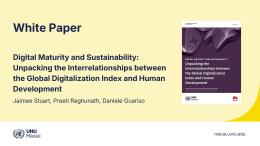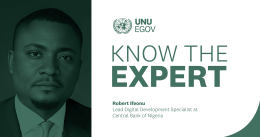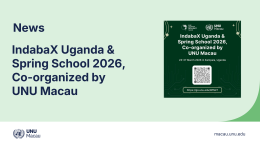As governments and communities worldwide accelerate their digital transformation, digital public infrastructure (DPI) is rapidly becoming a crucial component of modern governance, effective service delivery, and robust civic engagement. DPI is profoundly changing how people access essential services, exercise their rights, and interact with government agencies.
This is thanks to things like universal digital identification systems, seamless electronic payment networks, and secure data sharing platforms. These infrastructures are not neutral; their design decisions, governance mechanisms, and underlying beliefs have a significant impact on how they work. In this changing world, open source is a uniquely effective way to ensure that digital systems truly work for the public good.
The Global Digital Compact and the Pact for the Future, both adopted in 2024, demonstrate that the global community is reaching a consensus on the need for a digital world that is open, fair, and inclusive for everyone. These important aims align with open-source technologies.
Open source strengthens both accountability and creativity by allowing anyone to examine the code, making it less likely that companies will lock users into their products, while facilitating easier adaptation to different local situations.
Public institutions benefit from lower long-term expenses, better control over their key infrastructure, and increased transparency. At the same time, local communities gain the priceless ability to customize technologies to match their changing and specific needs, rather than being compelled to choose solutions that work for everyone.
Why DPI needs open source
This method of designing DPI, which intentionally prioritizes openness and engagement at its core, has a profoundly positive impact on a digital future that is truly human-centered. Open-source code is available to everyone, creating a level of transparency that fosters public trust. People can be assured that there are no hidden agendas or features, which eliminates the ‘black box’ problem associated with proprietary software. This makes it much easier for independent specialists or civil society to check and verify the software.
Also, open-source software typically makes things safer. The ‘many eyes’ notion means that a global community of developers and security researchers can examine the code, identify bugs more quickly, and collaborate to resolve them efficiently, which typically leads to stronger and more stable systems.
Open source has numerous benefits in terms of cost-effectiveness and sustainability. Any software has initial development expenses, but open-source software significantly reduces ongoing license fees, which can be a substantial burden on public funds. It also makes the service market surrounding the open-source solution more competitive, which lowers the costs of implementing and maintaining it. Because projects are not tied to a single vendor’s business model, the solution remains stable and long-lasting.
Furthermore, utilizing open-source DPI is a significant step toward achieving digital sovereignty and independence for countries. It gives governments more control over their essential national infrastructure, which means they do not have to rely on foreign proprietary technologies as much. This reduces the geopolitical risks associated with vendor dependencies, allowing countries to determine their digital future.
Another significant benefit is that it can be customized to fit various locations. Open source provides a great deal of freedom, allowing you to modify, translate, and adapt code to accommodate local laws, cultural differences, language issues, and the specific needs of individual citizens. This ensures that DPI is genuinely designed for the people it serves, which will help it be more widely used and effective.
Ultimately, open source is about encouraging new ideas and collaboration. It creates an environment where developers, researchers, and public sector innovators can share their knowledge and build upon existing work. This shared intellectual commons accelerates innovation and prevents people from repeating the same actions over and over again, which is particularly important for developing countries.
Linking to global frameworks and making a difference in the real world
Open-source ideals align perfectly with the UN Secretary-General’s Our Common Agenda, which advocates for a more connected, inclusive, and effective multilateralism. Open-source DPI can help achieve the Sustainable Development Goals (SDGs) by fostering collaboration and sharing resources. This way, digital growth will benefit everyone, not just a select few.
Practical instances of open-source DPI are emerging worldwide, demonstrating its potential to transform various aspects. In some places, open educational materials are being widely used to help institutions incorporate digital public goods into their courses, making information more accessible to everyone. In some cases, strong protections are being implemented to ensure that DPI systems effectively safeguard human rights and key data protection principles.
Open code makes it possible for these pledges to be checked by others. Regional projects, especially in low- and middle-income countries, are demonstrating how open source can help people go online, enhance cybersecurity, and enable the public sector to develop innovative solutions tailored to the needs of local communities.
Getting through problems and building capacity
There are, however, still significant problems that need to be addressed before open-source DPI can be widely adopted. Many governments struggle to adopt, deploy, and maintain open-source technologies due to a lack of experienced technical staff in public administration. Inconsistent policies, a lack of cooperation among government agencies, and a lack of agreed-upon standards can all hinder the growth and integration of systems.
To get past these problems, you will need to take action. Governments need to invest money and personnel in open-source projects, not just as a one-time effort, but as a long-term investment in the country’s digital skills. It is essential to invest in training programs for government workers and encourage an open-source culture in government IT departments. This includes assisting local colleges and vocational schools in developing curricula that are suitable for their needs.
Additionally, it is crucial to have clear, supportive policies that prioritize or require the use of open-source solutions for DPI, as well as robust governance frameworks that foster collaboration and clearly define responsibilities. For everyone to be successful, governments, civil society groups, schools, and even businesses (which can provide services for open-source products) need to work together.
Lastly, actively supporting and participating in open-source communities ensures that DPI projects continue to improve and remain up to date.
Relevance for Africa
The argument for open source in DPI is especially strong for Africa. Many countries on the continent are investing in improving public services and making them more accessible online. Open-source solutions offer a viable and independent way ahead. Because Africa has numerous diverse cultures, languages, and laws, it requires technology that can be adapted to fit those contexts without incurring significant costs or becoming locked into proprietary ecosystems.
Open source makes this possible, and it also helps local innovation ecosystems thrive, improving the technical skills of people in the area. By making smart investments in open standards, regional collaboration, and creating expertise, African governments can leverage open source to outpace outdated systems, enhance the resilience of digital systems, and ensure that DPI supports the continent’s future ambitions for inclusive development.
Open source is not simply a method to improve technology, but it is also a way to give people more control over their own lives and economies throughout Africa.
The significant aspect about open source is that it can make technology more democratic, which in turn makes it more accountable, flexible, and accessible to everyone. But this guarantee will not happen automatically. It must be actively sought through purposeful design, continuous investment, strategic alliances, and a steadfast collaborative approach.
Digital systems are becoming increasingly integral to everyday life. The decisions we make now will have a lasting effect on how people are included, treated fairly, and able to participate in the future. Open source is not just a collection of technical tools; it is a strong base for crafting a digital future that belongs to everyone.
Suggested citation: Marwala Tshilidzi. "Building Digital Infrastructure Through Open Source and Its Possibilities," United Nations University, UNU Centre, 2025-07-02, https://unu.edu/article/building-digital-infrastructure-through-open-source-and-its-possibilities.






